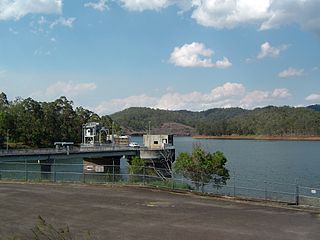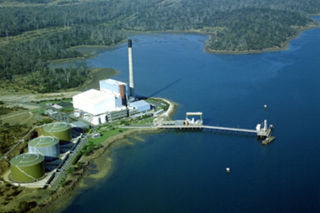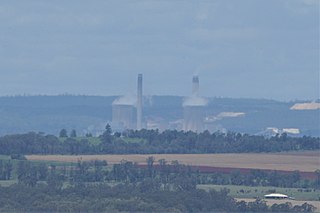
The Wivenhoe Power Station is situated between the Splityard Creek Dam and Lake Wivenhoe. The Splityard Creek Dam is located in hills adjacent to Lake Wivenhoe and is about 100 metres (330 ft) above it. The power station is the only pumped storage hydroelectric plant in Queensland.

The Yallourn Power Station, now owned by EnergyAustralia a wholly owned subsidiary of the Hong-Kong–based CLP Group, is located in the Latrobe Valley of Victoria, Australia, beside the Latrobe River. Yallourn PS was a complex of six brown coal–fired thermal power stations built progressively from the 1920s to the 1960s; all except one have now been decommissioned. Today, only the 1,450 megawatts (1,940,000 hp) Yallourn W plant remains. It is the second largest power station in Victoria, supplying 22% of Victoria's electricity and 8% of the National Electricity Market. The adjacent open cut brown coal mine is the largest open cut coal mine in Australia, with reserves sufficient to meet the projected needs of the power station to 2028. On 10 March 2021, EnergyAustralia announced that it will close the Yallourn Power Station in mid-2028, four years ahead of schedule, and instead build a 350 megawatt battery in the Latrobe Valley by the end of 2026. At the time, Yallourn produced about 20% of Victoria's electricity.
The Barron Gorge Hydroelectric Power Station in Queensland, Australia is an electricity power station commissioned in 1963 with a maximum capacity of 66 megawatts (89,000 hp). It is in the locality of Barron Gorge in the Wet Tropics World Heritage Area 20 kilometres (12 mi) north-west of Cairns. It replaced an earlier station which was the first underground power station in the country and the first hydroelectric station in Queensland. The power station was refurbished in 2006.

Munmorah Power Station is a demolished coal-fired power station with four 350 MW English Electric steam driven turbo-alternators for a combined capacity of 1,400 MW. The station was located near Doyalson, on the shores of Lake Munmorah, New South Wales, Australia and was owned and operated by Delta Electricity, a company owned by the New South Wales Government.

Wallerawang Power Station was a thermal coal power station, located near Wallerawang, in the Central Tablelands region of New South Wales, Australia. The power station was equipped with two turbo-alternators of 500 megawatts (670,000 hp) each, supplied by CA Parsons & Company of Newcastle-upon-Tyne, England. Production commenced in May 1957.

Stanwell Power Station is a government-owned coal-fired power generation station located in Stanwell, 23 kilometres (14 mi) south-west of Rockhampton, Queensland, Australia. At the time of construction, it was one of the largest industrial developments undertaken in Queensland. With a capacity to generate 1,445 megawatts (MW), Stanwell Power Station supplies electricity for distribution to customers via the state's high voltage electricity grid.
The Mackay Gas Turbine was a remote-controlled power generator that was owned and operated by Stanwell Corporation Ltd. for short periods when customer demand for electricity was high. The gas turbine's ability to start quickly played a role in ensuring a secure, reliable power supply for distribution to consumers.

The Bell Bay Power Station was a power station located in Bell Bay, on the Tamar River, Tasmania, Australia, adjacent to the Tamar Valley Power Station, with which it was often confused. It was commissioned between 1971 and 1974 as an oil fired thermal power station, and was converted to natural gas in 2003, after the commissioning of the Tasmanian Gas Pipeline, a submarine gas pipeline which transports natural gas from Longford, Victoria, under Bass Strait, to Bell Bay, Tasmania. As the power station's primary role was to provide system security in the event of drought for Tasmania's predominantly hydro-electric based generation system it only was rarely called on to operate, resulting in intervals of five to eight years between periods of significant use. After the commissioning of Basslink in 2006, the power station was decommissioned in 2009.

Callide Power Station is an electricity generator at Mount Murchison, Shire of Banana, Queensland, Australia. It is coal powered with eight steam turbines with a combined generation capacity of 1,720 megawatts (MW) of electricity. Callide A was commissioned in 1965, refurbished in 1998 and decommissioned in 2015/16. As of 2018, generation capacity was 1510 MW. In 2024, Peter Dutton said he intends, if elected, to build one of seven government-owned nuclear power plants on this site, to be operational by 2035–2037.

The Tarong Power Station is a coal fired power station located on a 1,500 hectares site in Tarong in the South Burnett Region near the town of Nanango, in Queensland, Australia. The station has a maximum generating capacity of 1,400 megawatts, generated from four turbines. Coal is supplied via a conveyor from Meandu Mine, which is 1.5 kilometres (0.93 mi) away and is also owned by Stanwell. Water is supplied from Boondooma Dam. In 2024, Peter Dutton said he intends, if elected, to build one of seven government-owned nuclear power plants on this site, to be operational by 2035–2037.

Stanwell Corporation is a Queensland Government-owned corporation. Stanwell is the state's largest electricity generator and Australia’s second-largest greenhouse gas emitter.

Tallawarra Power Station is a 435-megawatt (583,000 hp) combined cycle natural gas power station in Yallah, New South Wales, Australia. Owned and operated by EnergyAustralia, the station is the first of its type in New South Wales and produces electricity for the state during periods of high demand. It is located on the western shore of Lake Illawarra.
The Koombooloomba Dam is a concrete gravity dam with a controlled spillway across the Tully River, located west of Tully and south, southeast of Ravenshoe in Far North Queensland, Australia. Built for the purpose of hydroelectric power generation, the dam creates the reservoir, Lake Koombooloomba.

CS Energy is an Australia-based electricity generating company fully owned by the Government of Queensland with its head office located in Fortitude Valley, Brisbane. The company was established in 1997 and employs more than 500 staff. Adam Aspinall is the Board Chair and Darren Busine is the Chief Executive Officer.

The Tilbury power stations were two thermal power stations on the north bank of the River Thames at Tilbury in Essex. The 360 MW dual coal- and oil-fired Tilbury A Power Station operated from 1956 until 1981 when it was mothballed, prior to demolition in 1999. The 1,428 MW Tilbury B Power Station operated between 1968 and 2013 and was fueled by coal, as well as co-firing with oil and, from 2011, biomass. Tilbury B was demolished in 2016–19. Since 2013 three other power stations have been proposed or constructed in Tilbury.

The Trenton Channel Power Plant, also known as the Trenton Stacks, was a coal-burning power station located in Trenton, Michigan. Completed in 1924, it is owned by Detroit Edison, a subsidiary of DTE Energy.

The Hongkong Electric Company is one of Hong Kong's two main electricity generation companies, the other being China Light & Power. The company is owned by several companies including Power Assets Holdings, State Grid Corporation of China, Cheung Kong Infrastructure Holdings and Qatar Investment Authority. It was the first company to provide electricity in Hong Kong, having run continually since the 19th century.
The Hornsdale Wind Farm is an electricity generator in the locality of Hornsdale in the south-west of the Narien Range, north of Jamestown, South Australia. It consists of 99 wind turbines with a generation capacity of 315 megawatts (422,000 hp). The plant is owned and operated by Neoen, a French renewable energy company.
CleanCo Queensland is a Queensland Government-owned corporation. CleanCo owns and operates a range of electricity generation assets in Queensland, including run-of-the-river and pumped-storage hydroelectricity, gas-fired power plants, grid-scale solar farms and wind farms. The Queensland Government has a long-term ambition to generate 50 per cent of the state’s electricity from renewable sources by 2030. CleanCo was established in 2018.















